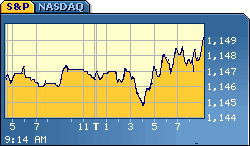Every morning between 11 and 11:10 a.m. a consortium of large banks send data to Reuters Group PLC in London to "fix" the London Interbank Offered Rate (LIBOR). This rate is being used to determine the rate that banks charge each other for short term loans. According to the WSJ there has been concern dating back as late as September last year that banks are understating the rates they report for LIBOR fixing. Recently the British Bankers Association (BBA) got involved and is now investigating these allegations. The accuracy and transparency of LIBOR has wide ranging implications since it is used as base for a number of loans. Misstatement can prove costly for borrowers around the world. One measure that reflects the general cost of borrowing is by comparing the three-month LIBOR with the yield on a three-month Treasury bill. The gap between the two stood at 1.58 percentage points Tuesday, and has averaged 1.39 percentage points since the crisis began in August. In the five years before the financial crisis started, it averaged only 0.28 percentage points.
Citigroup's Mr. Peng believes banks could be understating even those abnormally high Libor rates. He notes that the Federal Reserve recently auctioned off $50 billion in one-month loans to banks for an average annualized interest rate of 2.82% -- 0.1 percentage point higher than the comparable Libor rate. Because banks put up securities as collateral for the Fed loans, they should get them for a lower rate than Libor, which is riskier because it involves no collateral. By comparing Libor with that indicator and others -- such as the rate on three-month bank deposits known as the Eurodollar rate -- Mr. Peng estimates Libor may be understated by 0.2 to 0.3 percentage points.
A counter argument to Mr. Peng can be found in the way how LIBOR is calculated every day. Reuters throws out the highest and lowest quote submitted by banks. This practice likely curbs manipulation. Contributing banks would have to collude to achieve manipulation. The argument that banks are understating to hide financial stress does not hold up either. There are other distress signals, like CDS spreads on banks, that can be used .
source: LIBOR FOG - Bankers Cast Doub On Key Rate Amid Crisis
By CARRICK MOLLENKAMP
http://online.wsj.com/article/SB120831164167818299.html
Wednesday, April 16, 2008
The earnesty of being LIBOR
Posted by
Fred
at
6:05 PM
![]()
Subscribe to:
Post Comments (Atom)



No comments:
Post a Comment